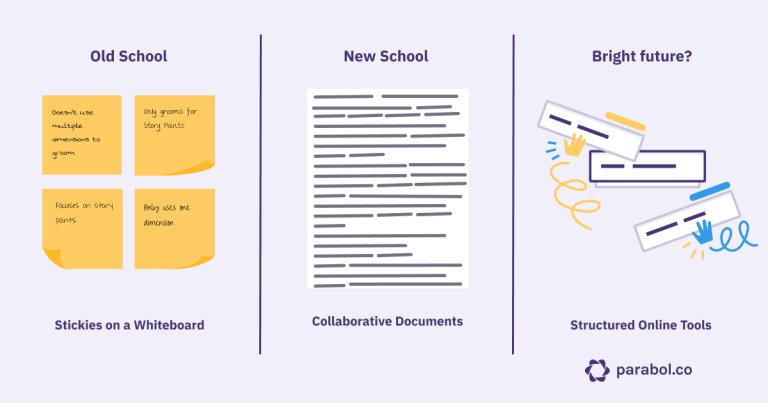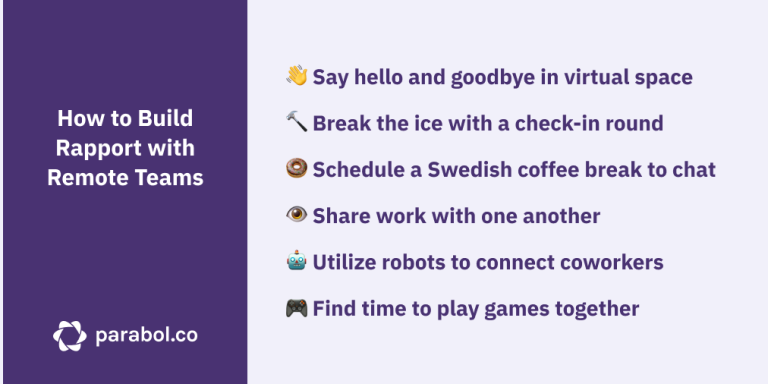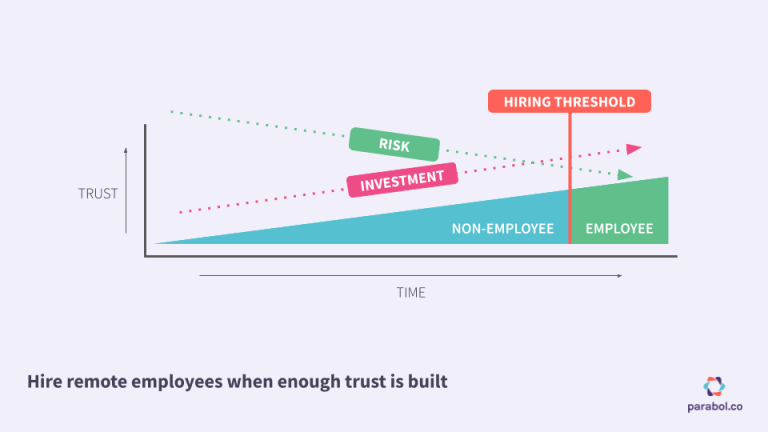How to Build Rapport with Remote Teams
The global pandemic forced the majority of knowledge workers to work remotely. Gone were bringing in breakfast bagels, hosting happy hours, intramural sports, break-room chit-chats, post-meeting consolations, and innumerable other ways we grew closer to our colleagues. Even fully-distributed organizations like ours had to abandon getting together every few months, a critical way we build rapport.
We’ve compiled a list of our best tips for building rapport among individuals and teammates. It’s a collection we plan to add to and keep up to date. If you have one to add, please write to us.
Team building matters because rapport makes you more effective and happier
Rapport, an amalgamation of trust and closeness, is a vital ingredient to team performance: –
- Rapport allows teams to take risks because it means we feel safe
- Rapport makes the work we do feel meaningful because we have others to share our accomplishments.
- Rapport saves time, because the more we understand one another, the less time we have to spend in explaining ourselves
So when you’re remote, what can you do to build team rapport? It must be deliberate. Without the serendipity of catching an employee in the hallway and sensing they might need to be taken out for coffee, we’ve got to somehow engineer these moments to happen. The good news is, research shows we can. Let’s look at a couple of examples.
More than 25 years ago, psychologist Arthur Aron succeeded in making two strangers develop a sense of closeness simply by having them ask each other questions that escalated in intensity. In 1997, the question set was refined along with Aron’s wife Elaine—also a clinical psychological researched—to 36 questions, which were popularized in a Modern Love column in the New York Times. However, “we had not created the 36 questions to help you fall in love,” shared Elaine Aron in Psychology Today, rather, “[we] needed…a method to create closeness in the laboratory with strangers.” While intentional conversation works well, rapport need not only be built with words.
Researchers from Brigham Young University in the US found newly-formed work teams experienced a 20 percent increase in productivity on subsequent tasks after playing video games together for just 45 minutes. The study, published in AIS Transactions on Human-Computer Interaction, adds to a growing body of literature finding positive outcomes of team video gaming.
So what can you do on your team? Here are some of our favorite ways.
Build individual rapport to support team building
Fundamentally, teams are made of people, so team dynamics are the product of a network of personal, one-on-one relationships. To build a stronger team, leaders – whether they’re managers or not – can work on first building stronger individual relationships.
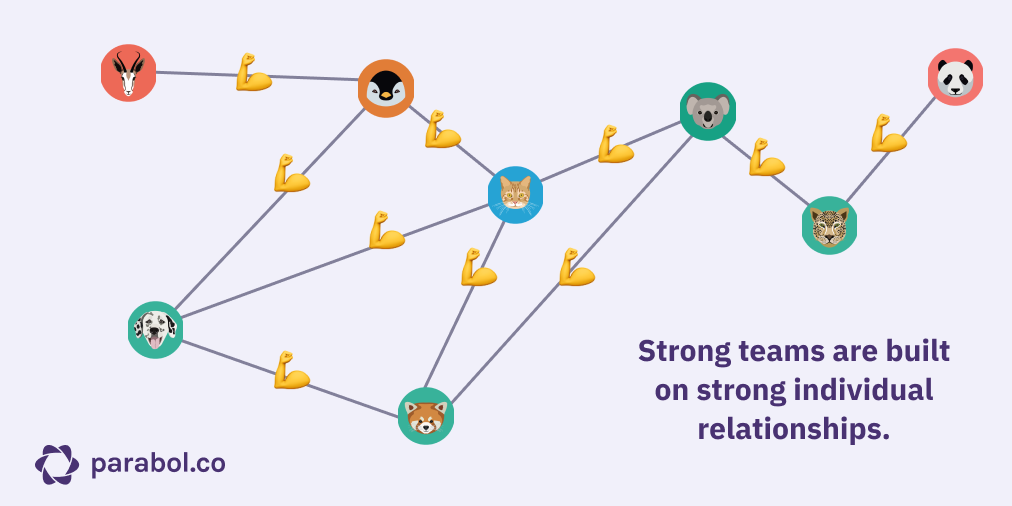
Escalate intimacy (without being a creep) by asking questions
If you are a manager, team lead, or even a peer, it’s not always easy to find the time or the proper context to ask questions that will deepen a relationship. Imagine out of the blue being asked, “Given the choice of anyone in the world, whom would you want as a dinner guest?” or, “For what in your life do you feel most grateful?” Here are a few guidelines to help:
- Use or adapt questions that are appropriate for the workplace and open 1:1 meetings with them. A question like, “What would constitute a ‘perfect’ day for you?” can easily become, “What would constitute a ‘perfect workday’ be for you?”. If you let team members know something like this is coming, it’ll help them feel comfortable.
- Schedule a team workshop or “Work From Home Happy Hour” and use a tool like Gatheround. Gatheround invites your team members to a virtual space and automatically breaks them down into small groups to ask each other work-appropriate questions of escalating intimacy. If you don’t want another tool, we’ve got a big list of icebreaker questions for you to try out.
Surprise team members to build connection
Building rapport doesn’t need to be a heavy exercise. Just sending a brief note goes a long way, especially when everybody is busy and doesn’t see each other face-to-face.
Use Slack reminders. Suppose you have an employee who is moving into a new apartment. During a team meeting, they mention how they are going to be offline for a day while they move. Moving sucks. We all know that. Getting a little note, “thinking of you during your move, let me know if you need anything,” might go a long way. Suppose the employee is moving on July 1st. Type this into Slack:
/remind me to wish so-and-so good luck while moving on July 1
…and Slack will helpfully send you a reminder to send your note.
Send gifts and flowers. Did somebody have a baby or welcome a new pet into their life? Is it a work anniversary? Or even better, would somebody just appreciate a bouquet of flowers? Having a package show up addressed from the entire team to commemorate or celebrate an individual is a nice gesture, and with the profundity of available delivery services, easier to do than ever. With so many companies now working from home, it’s a great way to repurpose budgets previously spent on rent and snacks to tokens of affection that still serve to make people happy.
Build team rapport intentionally through rituals
Say hellos and goodbyes in virtual space like you would in physical space
In an office, you’ll instinctively say hello to someone when you first see them for the day. With a virtual team, that act of ‘seeing’ doesn’t happen – you may not ‘see’ someone for days on end!
Saying hello and goodbye is the simplest and easily the highest return tip on our list: establish an etiquette around checking in and checking out of work each day by announcing when your workday is beginning and when your workday ends on your team’s chat tool.
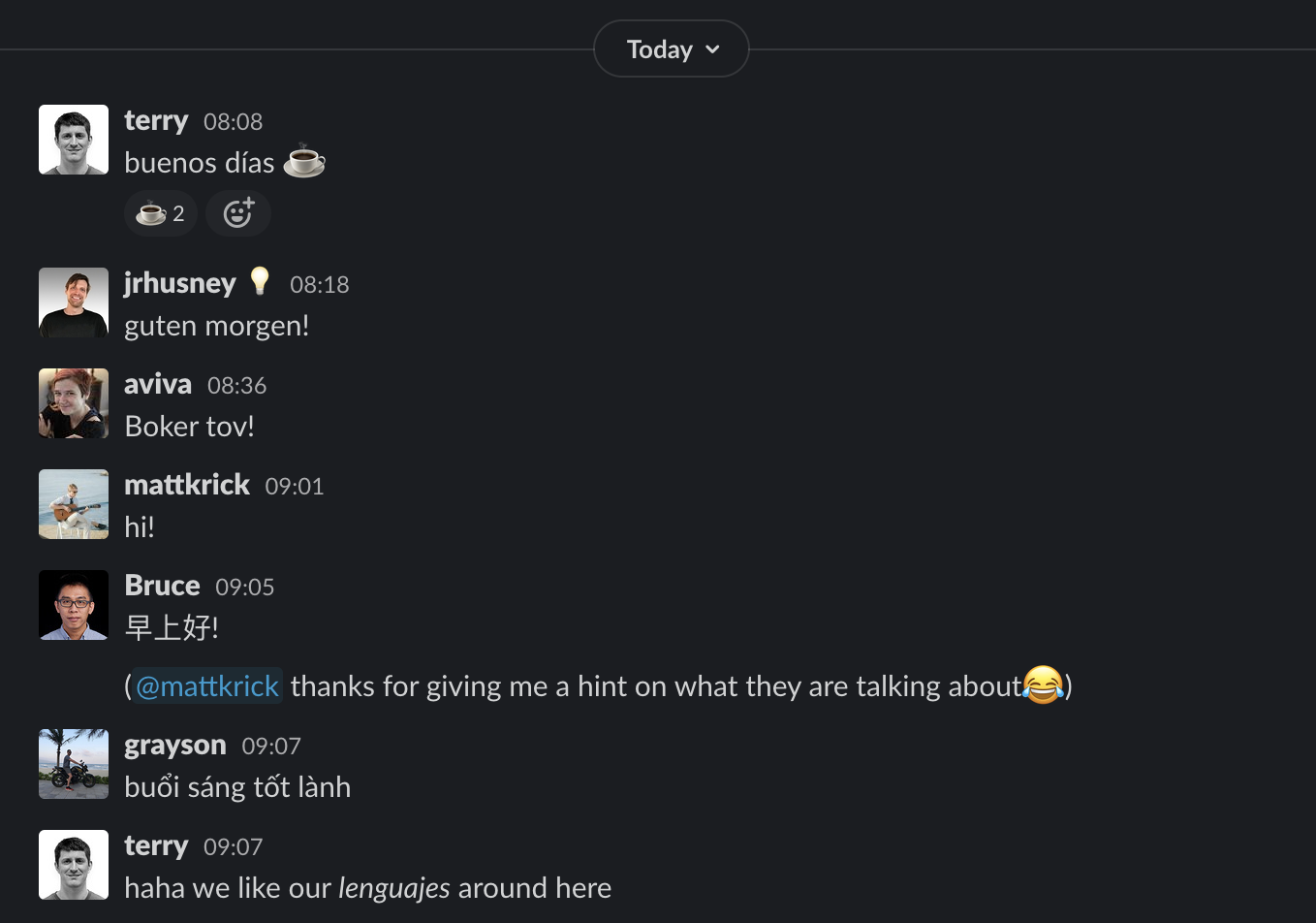
Starting each day with a greeting helps others know when you’re available and helps build a sense of presence and “bustle” within the company. A sweet way to make this practice even more powerful is to use the moment to announce the 1–2 things you intend to accomplish that day, and if you’re blocked or need anything from your teammates. At Parabol, this is part of our weekly check-in meeting cadence, giving each team member a chance to share their current state.
Whether it’s an update or just a hello, it’s helpful to have a channel in your chat tool dedicated to your team to make these announcements, or if your company is on the smaller size (fewer than 20 folks, say) a company-wide channel to make these announcements.
Stopping each day with a “check-out” message helps to punctuate the workday. Without a clear checkout, it’s fairly easy to feel like work never ends—and it becomes more difficult to have a sense of accomplishment or feel like its ever ok to step away, especially for remote teams. Sending a short note like, “I’m off today folks, see you tomorrow!” helps your colleagues know what to expect from you and it’s immensely helpful when your team is stretched across time zones.
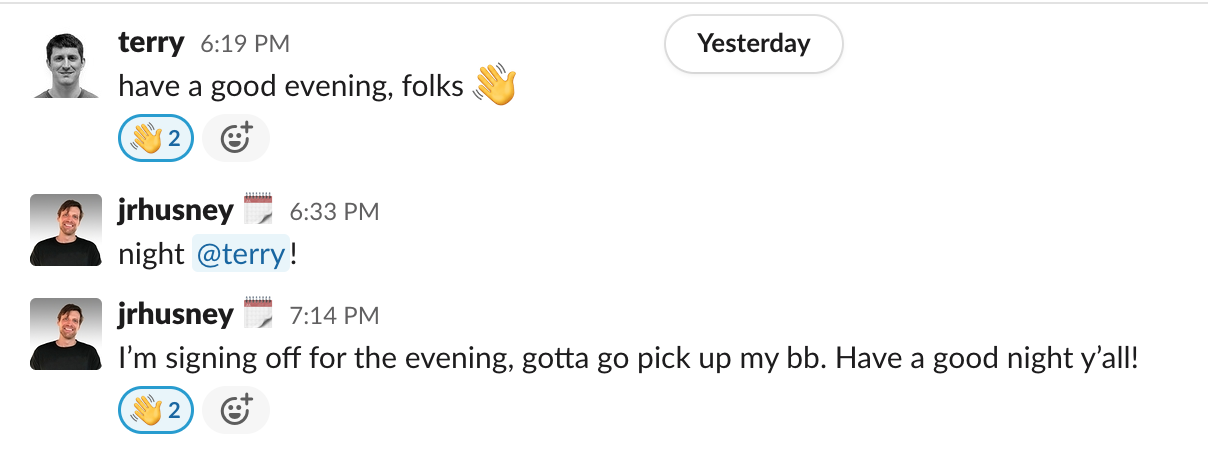
Break the Ice with a Check-In Round
While working from home, there are no chance encounters to get to know one another casually. We aren’t robots. We bring emotions with us to meetings. Providing a moment at the head of meetings to ask each other an icebreaker question helps us understand what state each teammate is in. You might discover that a teammate is distracted by family matters, or that they’re overwhelmed by their workload — sharing that context builds rapport and helps the meeting run more smoothly.
If you’re struggling for a default question to ask, our favorite check-in is,
Work aside, what has your attention today? What might be keeping you from being fully present?
If you’d like an extended list, we have a great collection of icebreaker questions as well as the does and don’ts of great icebreaker questions.
Orchestrating an Icebreaker round is simple. The meeting leader simply asks each meeting participant the same question and gives them the space to respond. We recommend guiding the team along so you can give each person their own time to have the floor all to themselves and keep the meeting on track.
If the icebreaker reliably takes 5 minutes at the head of each meeting, folks may look forward to this rapport-building habit rather than seeing it as taking away from the “business” of the meeting.
Schedule weekly moments for team-building like you would for all other essential activities
Gather for a virtual Fika when you can’t walk to your regular coffee spot
Fika is a style of coffee break practiced in Sweden that emphasizes socializing as much as caffeination. Multiple studies have correlated the practice of Fika with increased worker happiness and productivity. Our own research confirmed that taking coffee breaks with coworkers correlated with a sense of being able to bring your full, candid self to work — even more closely than with other planned social activities.
Our team has a standing, optional, once-per-week Zoom gathering we call Fika to have completely unstructured chit-chat. Bringing a beverage is encouraged.
As your company grows, you can make a practice like Fika scale in the following ways:
- Use breakout rooms: when topics develop, people can break off into small groups to continue the discussion
- Have a rolling start: schedule Fika to stretch over 2 hours and invite folks to come as they wish
- Set Fika at the department or team level: by limiting attendance, you can keep intimacy high
We also have a Slack channel for Fika, so we can keep the discussion going outside of our designated slot.
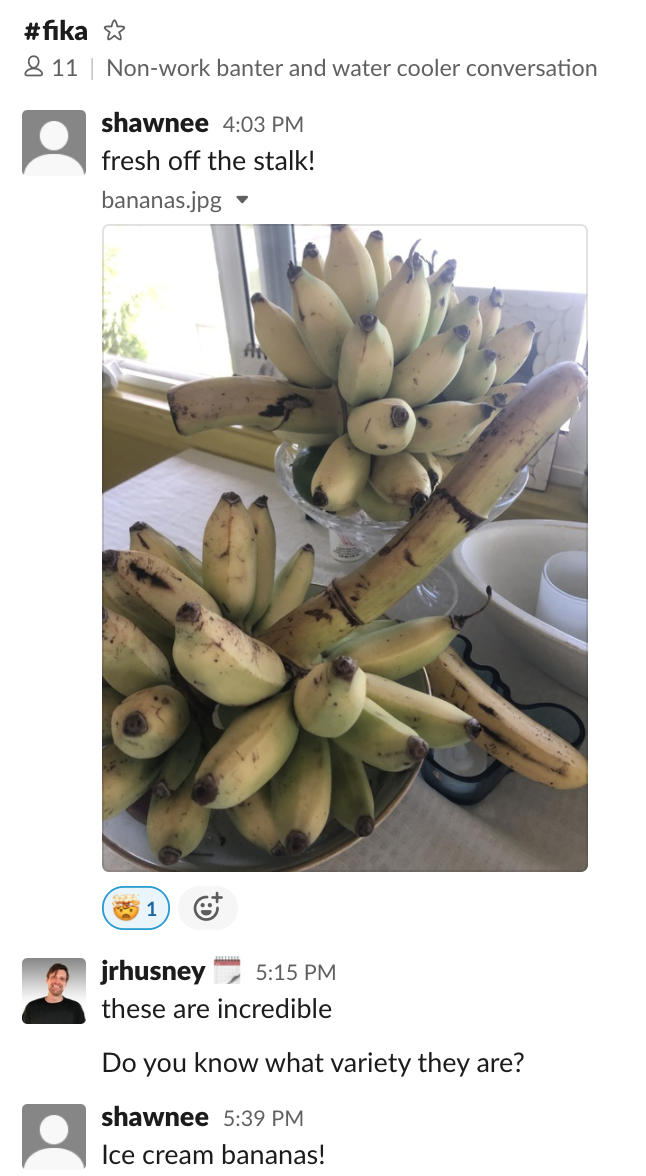
Demo work to make it come alive to coworkers
Remote workers don’t have the luxury of roaming the halls and peeking over shoulders to learn what’s going on. Sharing this sort of information is an intentional act. Showcasing great work (or work that has the potential to be great work) is vital to the success of any organization. How practically can an organization accomplish this? We suggest breaking down the problem into two parts:
- Gathering the work that’s a good point to be shared and
- Having a separate moment to highlight work and celebrate success
We gather work each Thursday by asking each team to elevate recently accomplished work as a series of bullet points. These bullet lists, rich with links to internal documents, trickle upwards in the organization. If work could benefit from being shown to others, it’s marked as such.
On Friday, we reserve a sliver of calendar time to share work with the broader team. These sessions are recorded so they can be shared with folks who are unable to attend. Incidentally, this process is how we collect stories to share externally in Parabol’s Friday Ship blog series.
Not only do these habits make teams aware of each other’s work and help keep information flowing between teams, but these practices also help strengthen emotional connections between colleagues and reinforce that their contributions are meaningful.
Engineer serendipity with the help of robots
There are a plethora of “bots” that can be added to popular chat platforms to regularly pair up team members who don’t know each other well to spread trust and collaboration across an organization. Some of the products we like in this space:
Start building rapport with your team one-one-one and all-together
As teams navigate the shift to remote work and consider settling into it for a longer period, we will need to adjust our in-person tools for building connection to a new online reality.
On an individual level, we can start by asking one another questions and surprising each other with kind notes.
For teams, we can deepen our rapport through daily, weekly and occasional rituals:
- Say hello and goodbye in virtual space
- Break the ice with a check-in round
- Schedule a Swedish coffee break to chit chat
- Share work with one another
- Utilize robots to connect coworkers
- [BONUS] Find time to play games together
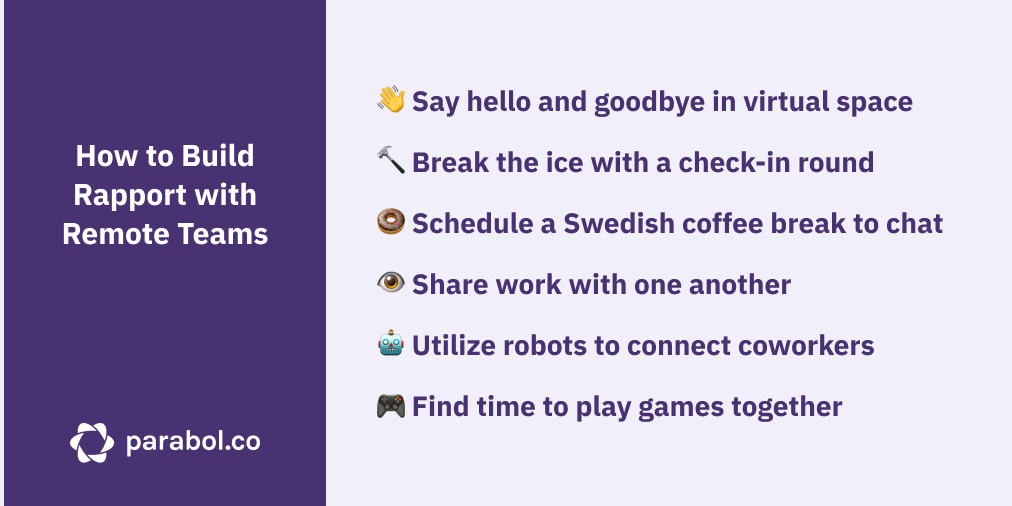
We hope these ideas help you and your team get closer together. And if you have a suggestion for something to add, or want to share what’s worked for you, drop us a line.






